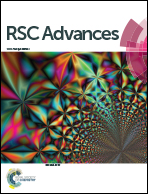Gold nanoparticles coated with a polydopamine layer and dextran brush surface for diagnosis and highly efficient photothermal therapy of tumors†
Abstract
In this study, multifunctional nanoparticles were fabricated for tumor diagnosis and therapy. The gold nanoparticles, which were prepared from HAuCl4 and aspartate via in situ UV irradiation, were coated with polydopamine (PDA) by self-polymerization of dopamine. Subsequently, the Au@PDA nanoparticles were coated with the BSA–dextran conjugate (BD). The photothermal transduction efficiency of the Au@PDA@BD nanoparticles was 17.0%. During 808 nm laser irradiation, the temperature rise and photothermal cytotoxicity of the Au@PDA@BD nanoparticle solution depended on the polydopamine concentration. Because of the Au core, the Au@PDA@BD nanoparticles improved the brightness and resolution of tumor CT imaging after intratumoral injection of the nanoparticles into H22 tumor-bearing mice. Due to the dextran brush surface, Au@PDA@BD nanoparticles could prolong the circulation time in blood and accumulate at the tumor site after intravenous injection, and thus NIR laser irradiation could cause the tumor temperature to rise to ablate the tumor completely. Only once treatment by intravenous injection of Au@PDA@BD nanoparticles into the tumor-bearing mice followed by 808 nm laser irradiation for 10 min could completely cure the tumors even if the original tumor volume was about 250 mm3. At the same conditions, Au@PDA nanoparticles without the dextran brush surface had no treatment efficacy. Furthermore, Au@PDA@BD nanoparticles plus the laser irradiation had no histological toxicity on the main organs of the treated mice. The Au@PDA@BD nanoparticles show a great potential for highly efficient photothermal therapy of tumors.


 Please wait while we load your content...
Please wait while we load your content...